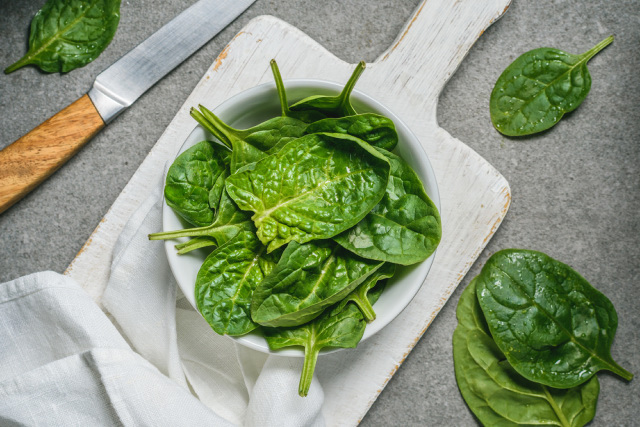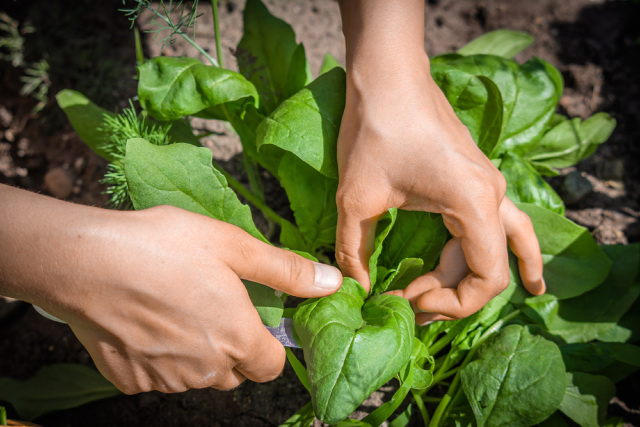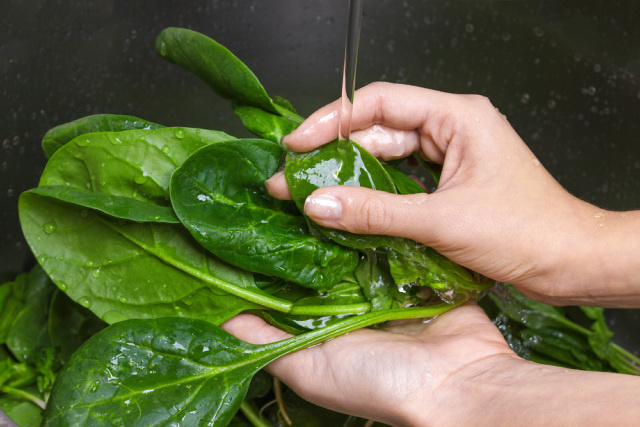As one of the healthiest green vegetables you can grow or buy, spinach tastes great, both raw and cooked. However, for many people, a single bad experience with the vegetable or a childhood memory of not liking it causes them to stay away from eating it very often. I’ll admit that spinach can sometimes taste slightly bitter, which may deter some palettes. Here, I’ll discuss why spinach can sometimes taste bitter and how you can remedy it and enjoy this delicious vegetable better.

Table of Contents
- Why Is My Spinach Bitter?—The Short Answer
- Can You Eat Bitter Spinach?
- How Does Oxalic Acid Cause a Bitter Taste in Spinach?
- How Does Harvesting Spinach Too Late Cause a Bitter Taste?
- How Can I Choose Spinach that Tastes Less Bitter?
- How Can Cooking Spinach Cause a Bitter Taste?
- How Can I Take the Bitterness Out of Spinach?
- How Can I Tell If My Spinach Has Gone Bad?
Why Is My Spinach Bitter?—The Short Answer
Spinach tends to have a more bitter taste than other vegetables due to the oxalic acid inside of it, which tastes bitter when it mixes with the saliva in your mouth as you eat it. Spinach can also taste more bitter if harvested too late, overcooked, or cooked on pans made of certain “reactive” materials.
Can You Eat Bitter Spinach?
Yes, spinach is a bitter leafy green (like kale, cabbage, arugula, and broccoli). The bitterness in spinach is caused by the compounds within the leaf and does not indicate anything wrong with the vegetable. It’s not harmful to eat bitter-tasting spinach, as long as the bitterness isn’t caused by the spinach rotting or starting to go bad.
How Does Oxalic Acid Cause a Bitter Taste in Spinach?
Spinach has a compound called oxalic acid (an insoluble form of calcium), which is responsible for its bitter taste. Surprisingly enough, the compound itself isn’t bitter tasting; instead, it’s the reaction it has with your saliva that makes it taste bitter.
As you chew on the spinach, the oxalic acid makes crystals that stick onto your teeth and cause that notable “bitter” taste that some people describe as tannins.
Some say that cooking the spinach will reduce oxalic acid and counteract the bitter taste. Still, there’s no real proven theory to that, and as you’ll see in a few minutes, in some cases, cooking the spinach can also bring out more bitterness.
How Does Harvesting Spinach Too Late Cause a Bitter Taste?
Since spinach is a cool-season crop, it tends to “bolt” when the temperatures get too warm, or the sun is too hot. For this reason, ensure that you harvest spinach from your garden as soon as it has matured (usually only 35 to 45 days after planting). Leaving it too long makes it more susceptible to the environment.
Also, ensure that you harvest the spinach before the leaves start to yellow. If the leaves are yellow or the plant starts to grow flowers, you waited too long to cut the spinach from the garden, and it will taste even more bitter than it should.
As a general rule, the larger the leaves, the more bitter the spinach will taste. So many gardeners who grow flat-leafed spinach keep watch and harvest the leaves from their spinach plants when they are still very young (15 to 35 days after planting). Spinach harvested at this time is called “baby spinach.”
Related: Why Is My Spinach Flowering? Causes and Solutions

How Can I Choose Spinach that Tastes Less Bitter?
When you shop for fresh spinach at the store or farmer’s market, look for the freshest leaves possible. Fresh spinach will always appear crisp and bright green.
As I mentioned when discussing harvesting, spinach’s smaller, younger leaves taste less bitter than the larger, more mature leaves. You can look for these smaller leaves when purchasing spinach in the grocery store to ensure you buy spinach with a milder taste.
In the grocery store, this option will be called “baby spinach.” The baby spinach leaves are much smaller and more tender than other types of spinach because they were harvested when the plant was very young.
If you opt to purchase baby spinach, it will have a less bitter taste and smaller stems, so you may find it easier to enjoy raw. Baby spinach is a very popular option for salads. Since these more mild-tasting leaves greatly appeal to many people, it’s generally easy to find baby spinach leaves at the grocery store.
How Can Cooking Spinach Cause a Bitter Taste?
As mentioned, some people claim that cooking spinach can help to counteract some of its bitterness. However, the other ingredients added to the spinach when cooking it are more likely to help with this process than the actual cooking process (we’ll talk about that in a minute).
I’ve found that if you cook spinach incorrectly, it can actually bring out more bitterness than eating it raw. In fact, the most common culprit for a robust bitter aftertaste with cooked spinach has to do with overcooking it.
Since spinach is a delicate green, it only needs to be lightly sauteed before eating to maintain its flavor and vitamin content. Cooking the spinach too long will cause it to wilt and taste bad, including more bitter. Most people that remember not liking spinach from childhood likely never had it cooked properly.
Another surprising culprit of bitterness in spinach has to do with the type of pan with which you cook it. If you cook your spinach in a pan made of iron, it will make your spinach (and other similar greens) taste more acidic and bitter. To reduce its bitterness, cook from a pan made of other more “non-reactive” materials, such as glass, ceramic, or stainless steel.
How Can I Take the Bitterness Out of Spinach?
Luckily, many ways exist to cut the bitterness out of spinach a bit as you prepare it. That way, you can enjoy the vegetables’ healthy vitamins and minerals, even if you don’t enjoy the natural, slightly bitter taste.
Always Wash Your Raw Spinach
As with any vegetables, make sure to always thoroughly wash your raw spinach under cold water before eating it or preparing it. This step removes any contaminants or pesticides and, in the case of spinach, also washes some of the polyphenols from the leaves. By removing some of these compounds, your spinach will have a less bitter flavor when you cook it.
If possible, purchase organic spinach. Spinach always appears on the “dirty dozen” list of vegetables with the highest levels of pesticide residue. You want to avoid this residue or remove as much of it as possible to improve the vegetable’s taste and one’s health.

Cut Off the Spinach Stems
If you’re preparing baby spinach, you likely don’t have very large stems and shouldn’t need to remove them before you prepare the dish. However, if your spinach has any large stems attached to it, you should cut them off before cooking or eating.
The stems tend to have a more bitter taste than the leaves, and removing them can make your dish more palatable.
Add Milk to Neutralize Spinach Bitterness
Although most people probably don’t think about mixing milk and spinach, it does a great job of neutralizing bitterness. You can simmer your spinach in milk and drain it when it’s finished.
If you’ve ever eaten creamed spinach, it’s prepared with milk and butter and has a delicious taste that many people enjoy. Spinach also makes a great ingredient in cream-based soups for this very reason.
Balance Spinach With Other Ingredients
Add salt or sugar to your spinach when you saute it to help mask some bitterness but not compromise any nutrition. You may also want to squeeze some lemon on it, and the acidity will also balance the taste.
Other ingredients that pair well with spinach include garlic, sweet or caramelized onions, bacon, and honey.
Since spinach blends well with these other flavors, you can adjust the taste to your preference to counteract the bitterness of the spinach.
Use Olive Oil When Cooking
Whenever you saute spinach, use olive oil or butter. These healthy fats will reduce the bitterness of spinach. They also help to prevent overcooking and enhance the overall flavor.
Blanch the Spinach
This popular method is said to reduce the bitterness of spinach instantly. Put the leaves in boiling water for about two minutes to blanch the spinach. Then, remove them from the hot water and quickly immerse them in icy cold water for a minute before you drain all of the liquid.
The spinach will taste less bitter and also retain its nutrients and its bright green color.
How Can I Tell If My Spinach Has Gone Bad?
Chances are that you likely won’t find yourself eating bad spinach, as it’s pretty easy to tell when this vegetable is past its prime. If your spinach looks slimy, loses its bright green color, or starts to smell pungent, it’s time to toss it in the compost or the trash.
Spinach that’s starting to rot will always have a bad smell and a slimy and mushy texture. Once exposed to moisture and air, spinach will go bad rather quickly. Therefore, I recommend using fresh spinach very soon after you purchase it or harvest it. If you can’t use it right away, you can freeze it (blanching it first).
However, if you ensure it’s completely dry, wrap it in paper towels, and store it in the refrigerator, you may be able to keep it fresh for a week or longer. The key to keeping it fresh is to ensure that you don’t allow any moisture to enter the container you use to store it, so don’t wash it before you put it in the refrigerator. Wash it right before you use it instead.
Related Reading:
- How To Freeze Kale: Preserving Your Kale Harvest
- Why Is My Mint Bitter? Answered!
- How To Grow Swiss Chard For Fast Leafy Green Vegetables
- Why is Celery Bitter (And How to Fix It)
- Why Is My Zucchini Bitter? (And how to fix it!)
- Growing Kale: Planting, Caring, and Harvesting Kale
- Why Is My Cabbage Bitter? Answered!
